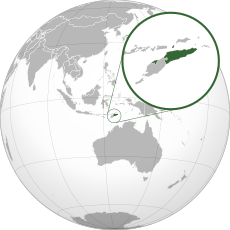Republik Demokratik Timor Leste ((Portugis: República Democrática de Timor-Leste,[5] Tetum: Repúblika Demokrátika Timór-Leste), toi ko' lobi otutunan sabaagi Timor timur nopo nga iso pogun id kopulauan ii poingiliu id Asia tenggara, om miwolit do Kopulauan Timor (Indonesia) id kosilahon. Timor Leste nopo nga kahangkum do pulau Atauro, Jaco, Oecussi-Ambeno om soboogian Pulau Timor.
Democratic Republic of Timor-Leste
| |
|---|---|
| Motto: Template:Wp/dtp/Native phrase "Unity, Action, Progress" | |
| Anthem: Template:Wp/dtp/Native phrase "Fatherland"Template:Wp/dtp/Parabr | |
 | |
| Capital | Dili 8°33′S 125°34′E / 8.55°S 125.56°E |
| Largest city | Dili |
| Official languages | |
| National languages | |
| Working languages | |
| Religion (2015 census)[1] | Template:Wp/dtp/Ublist |
| Demonym(s) | |
| Government | Unitary semi-presidential republic[4] |
| José Ramos-Horta | |
| Xanana Gusmão | |
| Legislature | National Parliament |
| Independence | |
| 16th century | |
| 28 November 1975 | |
| 17 July 1976 | |
• Administered by UNTAET | 25 October 1999 |
| 20 May 2002 | |
| Area | |
• Total | 14,874 km2 (5,743 sq mi) (154th) |
• Water (%) | Negligible |
| Population | |
• 2021 estimate | 1,340,513 (153rd) |
• 2015 census | 1,183,643[5] |
• Density | 78/km2 (202.0/sq mi) (137th) |
| GDP (PPP) | 2023 estimate |
• Total | |
• Per capita | |
| GDP (nominal) | 2023 estimate |
• Total | |
• Per capita | |
| Gini (2014) | 28.7[7] low |
| HDI (2021) | 0.607[8] medium · 140th |
| Currency | United States dollarb East Timor Centavo (USD) |
| Time zone | UTC+9 (Timor-Leste Time) |
| Driving side | left |
| Calling code | +670 |
| ISO 3166 code | TL |
| Internet TLD | .tlc |
| |
Timor Leste nopo nga nokosuang do Republik Indonesia ontok toun 1975 om minidu ontok toun 1999. Timor Leste nopo nga nakaanu do kagabasan ontok Mei 2002.
Pomungaranan edit
"Leste" id boros Portugis nopo nga kirati do kosilahon sumuku do kinoiyonon mononolod portugis id pulau Timot diti, maya diti namaan pinomungaranai ii id boros Portugis ii nokosilu nogi iso boros poimbida' id pogun diti, Timor-Leste ii kitanda sengkang; ngaran Portugis ngaran Portugis ii kisengkang namaan kadau gunoo masaan do mobi-mobi pogun di suminuang do Pertubuhan Bangsa Bangsa Bersatu ontok 2002. Ngaran "Timor Leste" ii misodu nopo nga insaru gunoon id media abal se-Nusantara muong pia id boros Malaysia (kaampai Bernama) om Indonesia (kaampai KOMPAS). Boros Tetum nopo nga mamarait ngaran diti sasbaagi Timór Lorosa'e (Lorosa'e kikomoyon do "koinsawaton tadau / "kosilahon")[9][10].
Ngaran Timor Leste nogi nga nokosiliu do "Timor Timur" id boros Melayu, ngaran diti nopo nga nopili montok Provinsi ii nowonsoi soira minononsog o koobian minopoinsodu Indonesia do pogun di id Operasi Seroja ontok 1975.
Sukuon edit
- ↑ "Nationality, Citizenship, and Religion". Government of Timor-Leste. 25 October 2015. Archived from the original on 14 July 2019. Linoyog ontok 29 January 2020.
- ↑ Hicks, David (15 September 2014). Rhetoric and the Decolonization and Recolonization of East Timor. Routledge. ISBN 9781317695356. Archived from the original on 26 March 2023. Linoyog ontok 12 October 2020 – via Google Books.
- ↑ Adelman, Howard (28 June 2011). No Return, No Refuge: Rites and Rights in Minority Repatriation. Columbia University Press. ISBN 9780231526906. Archived from the original on 26 March 2023. Linoyog ontok 12 October 2020 – via Google Books.
- ↑ Shoesmith, Dennis (2003). "Timor-Leste: Divided Leadership in a Semi-Presidential System". Asian Survey. 43 (2): 231–252. doi:10.1525/as.2003.43.2.231. Archived from the original on 14 April 2021. Linoyog ontok 24 August 2020.
The semi-presidential system in the new state of Timor-Leste has institutionalized a political struggle between the president, Xanana Gusmão, and the prime minister, Mari Alkatiri. This has polarized political alliances and threatens the viability of the new state. This paper explains the ideological divisions and the history of rivalry between these two key political actors. The adoption of Marxism by Fretilin in 1977 led to Gusmão's repudiation of the party in the 1980s and his decision to remove Falintil, the guerrilla movement, from Fretilin control. The power struggle between the two leaders is then examined in the transition to independence. This includes an account of the politicization of the defense and police forces and attempts by Minister of Internal Administration Rogério Lobato to use disaffected Falintil veterans as a counterforce to the Gusmão loyalists in the army. The December 4, 2002, Dili riots are explained in the context of this political struggle.
- ↑ "Population by Age & Sex". Government of Timor-Leste. 25 October 2015. Archived from the original on 25 January 2020. Linoyog ontok 29 January 2020.
- ↑ 6.0 6.1 6.2 6.3 "World Economic Outlook Database, October 2023". IMF.org. International Monetary Fund. October 2023. Linoyog ontok December 10, 2023.
- ↑ "Gini Index coefficient". CIA World Factbook. Archived from the original on 17 July 2021. Linoyog ontok 16 July 2021.
- ↑ "Human Development Report 2021/2022" (PDF). United Nations Development Programme. 8 September 2022. Archived (PDF) from the original on 8 September 2022. Linoyog ontok 8 September 2022.
- ↑ Amy Ochoa Carson (2007). "East Timor's Land Tenure Problems: A Consideration of Land Reform Programs in South Africa and Zimbabwe" (PDF). Indiana International & Comparative Law Review. 17 (2): 395. doi:10.18060/17554. Archived (PDF) from the original on 27 March 2022. Linoyog ontok 24 October 2022.
- ↑ "tetun.org". tetun.org. Archived from the original on 7 May 2021. Linoyog ontok 28 May 2021.

